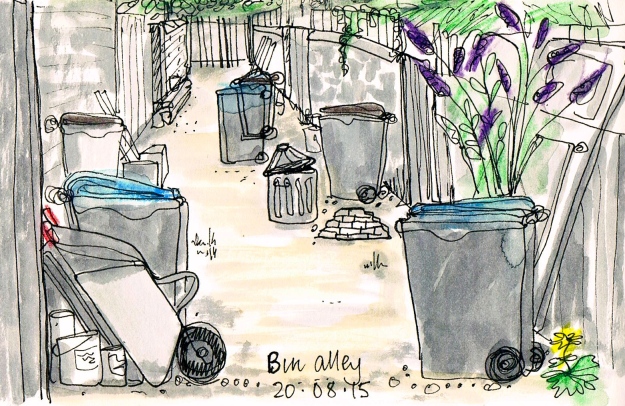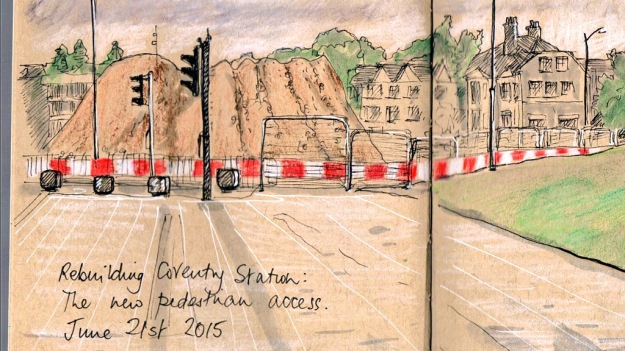I have drawn my garden and my street so many times I can’t generate any enthusiasm for yet another try – whereas the back alley is virgin territory – as far as sketching goes, I mean. It certainly doesn’t have a virginal look about it, even though these sketches make it look cleaner and tidier than it is.
Here the wheelie bin rules, along with difficult to dispose of hard-core, building materials and general rubbish. In my newfound role as psychogeographer-cum-urban-sketcher, I found myself pondering the links between the wheelie bin, consumerism, capitalism, and of course, psychotherapy. Psychotherapy, psychogeography, sketching – the words don’t roll off the tongue easily, but there is a fluid interchange between the three areas as far as I am concerned.
There is probably a long established sociological discourse on the wheelie bin, but apart from this interesting research project[i], I haven’t been able to track much down yet. So these are my uninformed thoughts!
The rise of the wheelie bin could be a metaphor for the rise of consumerism and an encroachment on the public by the private. Somewhere in the 1990’s it came to replace a system where ‘bin men’ – local government employees, collected metal bins, emptied and returned them to our gardens and backyards. Now it is the householders’ responsibility to take the wheelie bins to the public space of the pavement or roadside, and the ‘binmen’, working for private contractors, empty them and return them to any point along the street.
Many recycling centres – shared facilities- have gradually been overshadowed by roadside collections. Rubbish is a private affair, unlike for example, the French system where rubbish is taken to a communal area. Litter in the street is now deemed the responsibility of the council, whereas my grandparents would sweep the pavement outside of their house and expect the neighbours to do the same.
The size of the wheelie bin – about one and a half times that of the old dustbins –has legitimised a significant increase in waste as we buy more and more Stuff, along with its packaging. The way we handle rubbish illustrates the break down of a sense of community and shared ownership, the rise of consumerism and the packaging industry as well as the commercialisation of disposal. Waste is big business.
All this can be discretely ignored if you live in a large enough house to have a side entrance, or a large front garden to conceal your wheelie bins. Those in Victorian terraces with no/ tiny front gardens are forced to live with the bins as permanent plastic Daleks by their front door, who in time become disregarded and ‘normal’.
In the 1990’s too, my local alleyways were gated as a ‘security’ measure, no longer pedestrian pathways though the Victorian Edwardian housing stock. They passed from public into private space; a space where by and large, it was possible to deposit and forget any inconvenient truths – like the link between our consumption and climate change, for example. Again, the wider the alley (posher houses) the greater the space available. Poorer people can’t get away from their rubbish so easily, it would seem. If you can afford a new build however, Eric Pickles came to your rescue with new building regulations, which, whilst freeing developers of some inconvenient requirements to consider the environment, insisted that wheelie bins must have their own dedicated space.[ii]
So what about psychotherapy? Putting our emotional rubbish out of sight and trying to forget about it is a familiar story in all our lives. What we most fear to acknowledge is the back story, where our own culpabilities and shameful secrets lie at the bottom of the wheelie bin, concealed by more acceptable rubbish. The bad things people have done to us, traumas inflicted by others, are terrible enough, but our own cruelties and complicities are often more painful to acknowledge.
We are generally ashamed of our bodily functions, of mess, shit, pus, semen, vomit. We have designed a sewage system to sweep these down to the sea and beyond – where they can poison somebody or something else. But there are other things that won’t fit down the toilet that linger in our back alleyways and wheelie bins. Humans are messy, capable of unspeakable horrors that although repressed, damage the self, others and society. [iii]
It is one of the great strengths of group psychotherapy that it can provide a space where this distressing, painful remembering can take place, witnessed by others struggling with their own back stories of mess. Acknowledging culpability, discovering regret, facing up to past actions and the responses of others – not just the therapist – can begin a process of re-integration and healing.
Look again at the wheelie bin. What can it tell us?
———————————————————————————–
[i] No. 08-2003 ICCSR Research Paper Series – ISSN 1479-5124 Hidden mountain: The social avoidance of waste Edd de Coverly, Lisa O’Malley & Maurice Patterson
[ii] Architects Journal 13 May 2015 G.Wilkinson
[iii] Phil Wood writes about Lviv and the related attempt to forget the inconvenient and bloody history of genocide, in Walking Inside Out, ed, T. Richardson.






